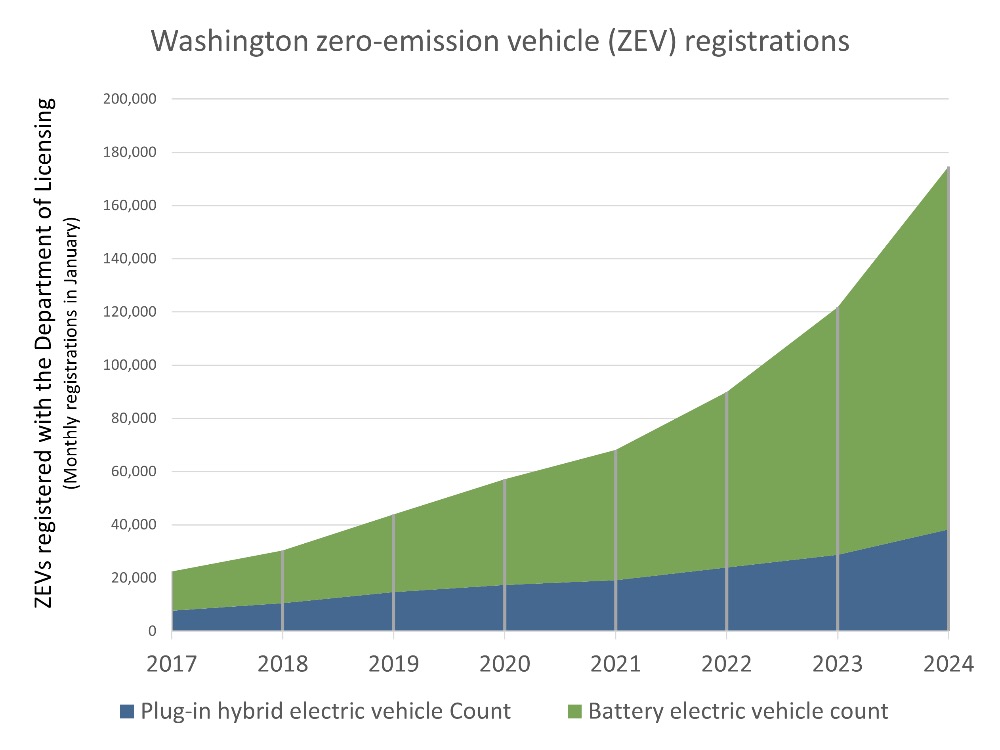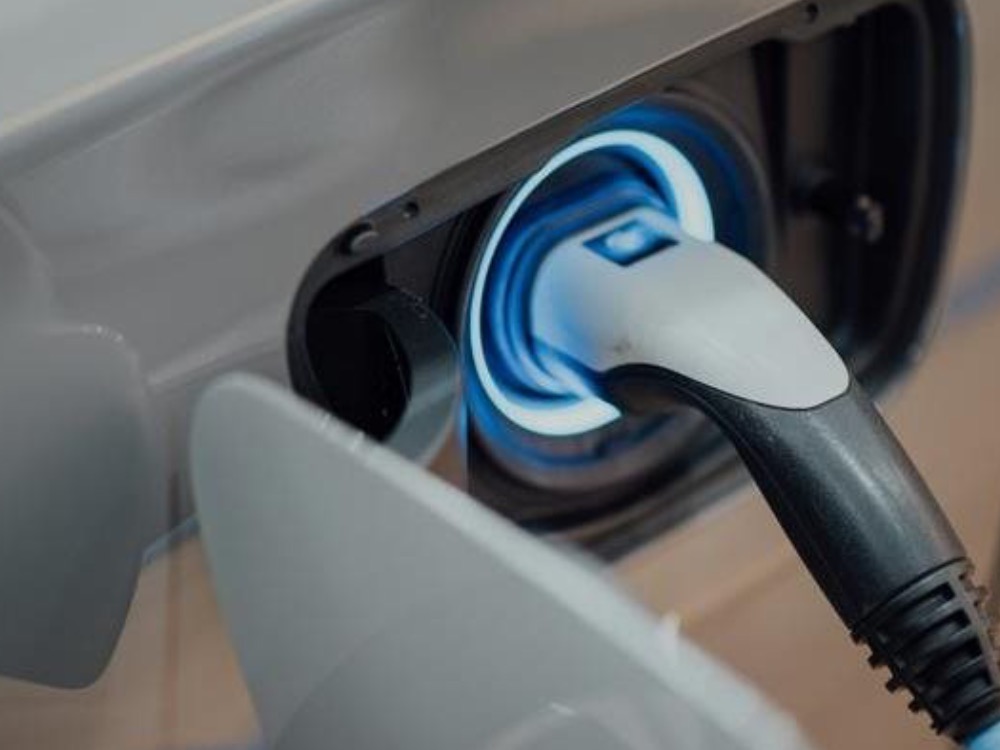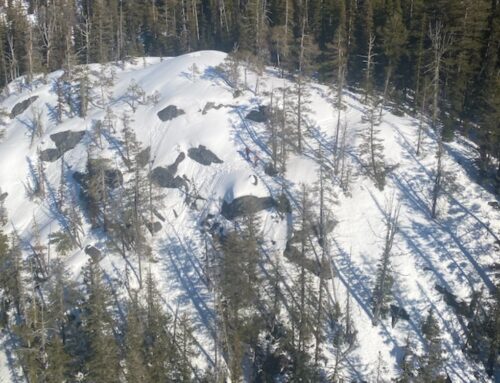Registrations jumped 43% and sales accounted for about 20% of all vehicles sold
information released by the Washington State Department of Energy
There have been recent news stories about a supposed slump in the transition to zero-emission transportation—that growth in electric vehicle (EV) sales has leveled off and manufacturers are scaling back plans for new models.
Here’s what you didn’t hear: None of that appears to apply to the West Coast, and it certainly doesn’t match what we’re seeing in Washington.
2023 was a record year for sales of electric and plug-in hybrid vehicles in Washington! Manufacturer data and newly available industry sales data show EVs and plug-ins accounting for about 20% of all vehicles sold in Washington last year.
That’s more than double the national sales average of 9.5%. With transportation being Washington’s biggest source of greenhouse gas emissions, this is welcome news.
Washington had the second-highest rate of electric and plug-in hybrid vehicle sales in the nation, right behind California. Which state came in at number three behind California and Washington? Oregon. The West Coast is way ahead of the rest of the nation when it comes to plugging into zero-emission transportation.
Digging into the data
The Alliance for Automotive Innovation’s latest report shows shows that electric and plug-in hybrid sales made up 18.8% of Washington’s new vehicle sales in 2023—up from 13% in 2022. Manufacturers also report vehicles delivered to dealerships for sale to the Department of Ecology, and those numbers show EVs and plug-ins as 22% of new vehicle sales. The difference comes from the lag between when cars are delivered to dealerships and subsequently sold to customers.
Washington also saw a huge jump in the total number of EVs and plug-ins registered in Washington. That figure rose from 118,050 in January 2023 to 168,850 by the year’s end, according to Department of Licensing data. That’s an astonishing 43% increase in a single year.

“Momentum for zero-emission cars and trucks has been slowly building for years,” said Joel Creswell, who manages the Washington Department of Ecology’s Climate Pollution Reduction program. “But 2023 is when all the pieces came together and car buyers in our state showed they were ready to trade the gas pump for the electric plug.”
Creswell oversees implementation of Washington’s zero-emission vehicle standard, which requires vehicle manufacturers to sell an increasing percentage of clean vehicles. By 2035, 100% of all new passenger vehicles and light-duty trucks sold in Washington must meet zero-emission requirements, meaning they do not release tailpipe air pollution. These include battery and hydrogen fuel cell-powered electric vehicles and plug-in hybrid vehicles with at least 50 miles of electric range.
Washington’s standards will accelerate the ZEV transition, but Washingtonians are ahead of the curve. The standards don’t kick in until model year 2025 vehicles start showing up on dealer lots sometime later this year. And even then, only about 8% of new vehicles sold are required to meet ZEV standards – a mark Washington car buyers have already far eclipsed.
What’s driving that surge in electric vehicles in Washington? Creswell pointed to a number of factors that played a role in making 2023 a turning point in clean transportation:
- Incentives: Federal EV incentives of up to $7,500 from the Inflation Reduction Act, combined with up to $4,000 in state incentives, helped make zero-emission vehicles more affordable than ever.
- Consumer choice: The number of EVs offered from every major manufacturer has grown by leaps and bounds in recent years, with over 110 unique EV models currently available. This includes key categories like full-size pickups, where buyers can now choose from the Ford Lightning, the Rivian R1T, the Chevrolet Silverado EV, and the Tesla Cybertruck; or seven-passenger SUVs, where buyers can choose from models offered by Kia, Tesla, Rivian, Mercedes, and Vinfast, with more on the way in 2024.
- Competition: Tesla repeatedly cut prices on its popular Model 3 and Model Y vehicles and other manufacturers followed suit. Forecasts show production costs continuing to drop for EV manufacturers, potentially paving the way for more cuts in the future.
- Early action by Ecology: Although the ZEV standards don’t start until 2025, Ecology updated its rules last year to give manufacturers credit for ZEVs sold in 2023 and 2024. This meant more choices for Washington consumers than had been the case in the past.
The road ahead
As noted, Washington’s ZEV standard kicks in for 2025 model year vehicles, requiring about 8% of new vehicles to qualify. In 2026, however, that standard jumps up to 35% and continues climbing until we reach 100% in 2035.
The early action credits Ecology is awarding to automakers for sales in 2023 and 2024 will help to smooth the adoption curve by making a wider range of EV models available in Washington sooner.
Another important area of growth is in EV charging infrastructure. Washington’s Climate Commitment Act and Clean Fuel Standard are paving the way for major investments in EV charging infrastructure and are addressing barriers to EV ownership – such as adding EV chargers in apartment buildings and in publicly accessible spots so that EV ownership is a realistic choice for people who can’t charge in their garage or driveway. For example, the CCA is helping to fund nearly 5,000 new community charging stations throughout the state.
And Ecology and other state agencies are working together to implement the state’s Transportation Electrification Strategy, which will keep the shift to zero emission transportation running smoothly by directing state funding to where it’s most needed and identify future challenges and opportunities.
Nationally, big things are happening, too. The Inflation Reduction Act is making major investments in EV charging, and Tesla, which operates the largest existing network of high-speed EV chargers, is opening up its equipment to other automakers.
Do I have to start driving in EV?
Switching to an EV isn’t mandatory. Even with ZEV standards going into effect, you can keep driving gas-powered vehicles if you choose. The standards apply to car manufacturers, not drivers. And they only apply to new vehicle sales within our state—used vehicles are exempt.
This may sound counterintuitive, but the jump in EV sales is actually good news for those who aren’t ready to part with their internal combustion car or truck just yet. That’s because fewer cars lined up at the gas pump reduces demand for gasoline, putting downward pressure on prices. Those effects may be hard to see now, since the roughly 175,000 EVs and plug-ins currently on Washington’s roads make up just 3% of all vehicles in the state. But market pressures will grow with as that figure increases.
For those on the fence, remember that ZEV standards will also increase the availability of plug-in hybrid vehicles with at least 50 miles of electric range. A number of vehicles for sale today approach that mark, and many more options are on the way. For example, Stellantis announced that its 2025 Ram 1500 Ramcharger pickup will be configured as a plug-in hybrid, featuring 145 miles of electric range and almost 700 miles of total range, along with 663 horsepower and a 14,000-pound towing capacity.
That’s just one example of the innovation that is driving the ZEV transition, Creswell said.
“Every month that goes by, we’re seeing more zero-emission choices offered in Washington,” Creswell said. “Prices are falling and performance is climbing – the future is looking very bright for ZEVs.”








